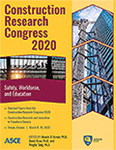Construction Research Congress 2020
Persistence of Women in the Construction Industry
Publication: Construction Research Congress 2020: Safety, Workforce, and Education
ABSTRACT
Women are under-represented in the construction industry and comprise only 9.9% of the total workforce. Further, prior research on women in construction is limited and heavily focused on recruitment and retention in academia. Therefore, research in workplace dynamics is needed to identify and address workforce recruitment and retention issues. Building from prior research conducted in engineering, this study aimed to identify personal and organizational factors associated with persistence within the field of construction. Persistence and personal factors were measured through the administration of a survey covering several areas: self-efficacy and outcome expectation, organizational support for work-life balance and training development, occupational commitment and satisfaction, and turnover intentions. Results suggest that women that persist in the field of construction do differ from non-persisters in their level of occupational commitment and perceived ability to navigate within their organization’s culture (organizational self-efficacy). Organizational self-efficacy and career resilience (occupational commitment) were shown to be significant predictors of persistence within the construction industry explaining 71.8% of the variance. These research findings will raise awareness and opportunities for companies to address recruitment and retention of women within the field of construction.
Get full access to this article
View all available purchase options and get full access to this chapter.
REFERENCES
Bandura, A. (2004). Cultivate self-efficacy for personal and organizational effectiveness. Malden, MA. : Blackwell.
BLS. (2019). Labor force statistics from the current population survey: Employed persons by detailed occupation, sex, race, and histpanic or latino ethnicity. Washington, D. C. : Bureau of Labor and Statistics Retrieved from https://www.bls.gov/cps/cpsaat11.htm
Carson, K. D., & Bedeian, A. G. (1994). Career commitment: Construction of a measure and examination of its psychometric properties. Journal of Vocational Behavior, 44(3), 237-262.
Choi, J. O., Shrestha, P. P., Lim, J., & Shrestha, B. K. (2018). An investigation of construction workforce inequalities and biases in the architecture, engineering, and construction (ACE) industry. Paper presented at the Consruction Research Congress 2018.
DOL. (2019). O*NET Online. Retrieved from https://www.onetonline.org/
Fouad, N. A., Chang, W.-H., Wan, M., & Singh, R. (2017). Women’s reasons for leaving the engineering field. Frontiers in Psychology, 8(875).
Fouad, N. A., & Guillen, A. (2006). Outcome expectations: Looking to the past and potential future. Journal of Career Assessment, 14, 130-142.
Fouad, N. A., Singh, R., Cappaert, K., Chang, W.-h., & Wan, M. (2016). Comparison of women engineers who persist in or depart from engineering. Journal of Vocational Behavior, 92, 79-93. https://doi.org/10.1016/j.jvb.2015.11.002
Greenhaus, J. H., Parasuraman, S., & Wormley, W. M. (1990). Effects of race on organizational experiences, job performance evaluations, and career outcomes. The Academy of Management Journal, 33(1), 64-86.
Hom, P. W., Griffeth, R. W., & Sellaro, C. L. (1984). The validity of mobley's (1977) model of employee turnover. Organizational Behavior & Human Performance, 34(2), 141-174.
Kay, K., & Shipman, C. (2014). The confidence gap. The Atlantic, 14, 1-18.
Morello, A., Issa, R. R. A., & Franz, B. (2018). Exploratory study of recruitment and retention of women in the construction industry. Journal of Professional Issues in Engineering Education and Practice, 144(2), 04018001.
NCES. (2013). Bachelor's, master's, and doctor's degrees conferred by postsecondary institutions, by sex of student and discipline division: 2011-12. Washington, D. C.: Institute of Education Sciences Retrieved from https://nces.ed.gov/programs/digest/d13/tables/dt13_318.30.asp
NCES. (2018). Bachelor's, master's, and doctor's degrees conferred by postsecondary institutions, by sex of student and discipline division: 2016-17. Washington, D. C. : Institute of Education Sciences Retrieved from https://nces.ed.gov/programs/digest/d18/tables/dt18_318.30.asp
Peters, L. H., Jackofsky, E. F., & Salter, J. R. (1981). Predicting turnover: A comparison of part-time and full-time employees. Journal of Organizational Behavior, 2(2), 89-98.
Singh, R., Zhang, Y., Wan, M., & Fouad, N. A. (2019). Why do women engineers leave the engineering profession? The roles of work–family conflict, occupational commitment, and perceived organizational support. Human Resource Management, 57(4), 901-914.
Stockbridge, C. M., Siddiqi, K., & Jollay, T. (2018). Best practices for attracting and retaining female construction project managers. Paper presented at the 54th ASC Annual International Conference Proceedings.
Sunindijo, R., & Kamardeen, I. (2017). Work stress is a threat to gender diversity in the construction industry. Journal of Construction Engineering and Management, 143.
Thompson, C. A., Beauvais, L. L., & Lyness, K. S. (1999). When work–family benefits are not enough: The influence of work–family culture on benefit utilization, organizational attachment, and work–family conflict. Journal of Vocational Behavior, 54(3), 392-415.
Wayne, S. J., Shore, L. M., & Liden, R. C. (1997). Perceived organizational support and leader-member exchange: A social exchange perspective. The Academy of Management Journal, 40(1), 82-111.
Information & Authors
Information
Published In
Construction Research Congress 2020: Safety, Workforce, and Education
Pages: 222 - 230
Editors: Mounir El Asmar, Ph.D., Arizona State University, David Grau, Ph.D., Arizona State University, and Pingbo Tang, Ph.D., Arizona State University
ISBN (Online): 978-0-7844-8287-2
Copyright
© 2020 American Society of Civil Engineers.
History
Published online: Nov 9, 2020
Published in print: Nov 9, 2020
Authors
Metrics & Citations
Metrics
Citations
Download citation
If you have the appropriate software installed, you can download article citation data to the citation manager of your choice. Simply select your manager software from the list below and click Download.
